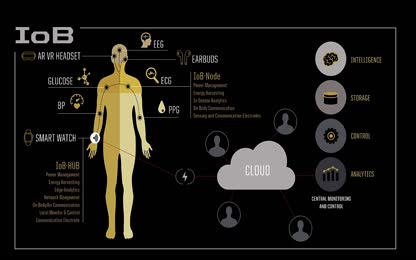Advertisement
2020 US Deaths No Increase Over Previous Years - Dr Briand of John Hopkins University
11 Comments
Video Transcript:
Welcome everyone to our webinar entitled COVID-19 Deaths, a look at U.S. data. I am Tasha Overpack, the event planner at the Advanced Academic Programs within the School of Pre-Gurage and Sciences at Johns Hopkins University. And today I will be moderating a webinar with our very own Genevieve Briand. Genevieve Briand is the Assistant Director for the MS and Applied Economics Program. She has taught for the applied economics program since summer 2015 and currently teaches microeconomic theory, statistics, and econometrics. She has many years of experience teaching numerous and varied economic and statistic courses. Her fields of interest are microeconomics and econometrics. Previously, she was an instructor at the University of Idaho, adjunct assistant professor of economics at Washington State University and a tenured associate professor at Eastern Washington University. She received her PhD from Washington State University. And with that, I'll go ahead and give it over to you. Thank you. Thank you, Tasha. So today is November 11, so I'd like to start by thanking all servicemen and women, veterans, and their family. So please, come, Mejune Viv. Today we'll be looking at very simple statistics and assess the effect of COVID-19 on U.S. death using data from the Centers for Disease Control and Prevention or CDC. Before we look at any data set, I will show you where I have found it on the CDC website. So you'll be able to go back to it later if you'd like. So this is a working progress. I just wanted to get the conversation started going rather. So what we're going to do is as a good through presentation, Tasha will help me with survey questions, call questions. And then through the presentation, I might invite you to think about a result. We will be looking at graphs. We'll be looking at, and that's what I'd like you to do that. So you can keep being engaged in the conversation. And then we'll take a Q&A, we'll do Q&A at the end of the presentation. All right. So specifically, today we'll be looking at data on weekly death, so all deaths per age group. And data on weekly death per cause of death. So why? Why are we not just looking at COVID-19? Because we cannot possibly assess the effect of the toll of COVID-19 on death in the United States by looking only at COVID-19 death. So another way to say this would be, we're all familiar with US COVID-19 death numbers, but not necessarily with US all death numbers. And how can we say COVID death numbers are concerning if we don't compare other to total death numbers? The numbers that we should expect every year. So we are starting with our first poll. I think we are all familiar with COVID-19 death numbers. So we want to check on that. So if you could participate in this poll, thank you, Tasha. So what do you think specifically here would be looking at numbers from in March to September 19th? What do you think the numbers are? How many COVID-19 deaths have we experienced in that time period, which is over six months? So 1500 to 2500, 15,000 to 225,000, 150,000 to 250,000 or 1.5 to 2.5 million. I see people are answering. Thank you. 78% of the attendees have answered the question. 80%. So over, does everybody see the answer to the poll, Tasha? Yes, thank you. Okay. So thank you. So everybody, so the majority of people have chosen 150,000 to 250,000, which is the correct choice. According to the CDC, we had experienced 198, 385 COVID-19 deaths during that time period. Thank you very much for participating. So although so now we're looking at the total death number. So in the previous creation, although the majority of you guessed that we had between 150 to 250,000 COVID-19 deaths, we still have 7% who thought we had 1.5 to 2.5 million. And 14% who thought we had 15 to 25,000. Now, for this one, thanks for your participation again. Since we gave, okay, so we have 58%, 65% of people voting, nobody chose the first group, which is reassuring. Okay, so the majority of people, again, guessed the correct number. I am surprised that still 25%, 24% of those who answered the survey chose 150,000 to 250,000, since we just, which is interesting, since we just abandoned out that those were the numbers for COVID-19 deaths. So it's important to note that COVID-19 deaths numbers represent only a fraction of US death number. And the result of that survey showed that it is very important to point that out. So we had over that same period, we had 1.7 million deaths. So we had 1.7 million deaths total death and 200,000 COVID-19 deaths, which mean we had 1.5 million other deaths. So deaths due to all the causes. I think it's important to put this COVID-19 number into perspective. I don't believe we've done that very much, so that's what we are doing here today. So it's important for a family of the 1.5 million for the family and friends of the 1.5 million individuals who passed away over that time period. By concentrating on only COVID-19, we seem to have forgotten about everybody else, all the other individuals who passed away. And every individual is unique. Every individual has something to offer and every individual's life is important. So thanks for your participation in those polls. Now we're going to go to our next slide. And look at those data that we set out to look at. So to get there, we go to the CDC website, so CDC.gov, everybody knows it. And then we go to learn more about COVID-19. On the next page, we select the cases and data path. And there on the menu, I don't list, we select COVID view weekly. So that's a link that takes us to this page. On this page, we scroll down all the way down to that page to the link, COVID-19 or death counts for COVID-19. I know what you're saying. We don't want to look only at COVID-19 death number, but that's actually where we are going to find all the counts for edge group as well. So the next page, we select weekly updates by select demographic and geographic characteristics. And on that page, we scroll down all the way to this table. And I believe this table we're all familiar with as well. So with the peak of COVID-19 death numbers from week ending April 11 to week ending April 25. The count of deaths due to COVID-19 went up and now they're going down. This specific table, this website was consulted on October 15. So if you go to this page right now, it might look slightly different. So this is actually the first page of these tables. You see the bottom where I saw called in pink. It says one of three. So first page of three. So we're going to go to the second page to find the data that we are looking for. And so on the second page, you can see at the bottom there in pink two of three. So we are at the second page. What I've done is just select each row of that table and then copied and pasted it in my spreadsheet. You can easily do that too to check on what we're doing today. And you can choose the different spreadsheet than the one I'm using. Okay. So once I've downloaded this data and then I made this graph. So I used Excel, but you can use another software. This is a 100% stacked column graph. Using the data, we just downloaded and I'll show you where we found the data. So what does this graph tell us? So it shows the percentages that each edge group contribute to the two death numbers with each column, each bar over here, a represent a weak worth of death. And so then for so it's 100% death for each bar. And then the upper section of it is light blue. That's the percentage out of the tutorial from COVID-19 death of 85 year olds 85 years old and older. Then below that it's in orange. It's the percentage of the total death that weak from individuals who were edged between 75 and 84 years. Okay. So and so on. Now that we know what each bar represent, or each column represent, what do you notice about this graph? What do you notice about the color pattern? So we have 32 weeks of data from week one ending of February 1st to with 32 ending September 15th. So it's a different time period than the time period that I mentioned and I gave you a number of death earlier for all calls. And that's good because we have weeks pre-COVID-19, right? We didn't have COVID, we didn't have information on COVID-19 in February yet, right? So some of those weeks over here are pre-COVID-19. So anything striking about the pattern of those total deaths across edge groups to you. Well, what's surprising to me is whether the blue chunks, so representing the death of older people, they're pretty much the same, right? The same length throughout. Same thing for the older other edge group, right? Which means the percentage of older people who passed away every week as a percentage of true people who passed away doesn't change over the weeks shown here. And that's surprising to me because we've been told that COVID-19 was taking a tool specifically on older people, right? So I would have expected that percentage to go up during the weeks of peak COVID-19 death, peak COVID-19 death, which are weeks 11 through 13. And we don't have that. So that's surprising to me, right? That those the size of those chunk of the column in different color pretty much stay the same throughout weeks. So that's one thing that's puzzling to me. What else is important about this graph and the numbers are drawn to here. What is it worth emphasizing? Well, every week, individuals of all edge groups pass away. All edge groups, there are 530 individuals 14 years and younger, the past year, where every week in the United States during that time period, an average of over 60,000 individuals die per week in the United States between that time period. So we can say that 50,000 to 70,000 deaths per week in the United States is normal. It is to be expected. And individuals in every edge group pass away every week. I know we don't like to say we don't like to say that it's normal. But it is. And the good news is, every week, a much higher number of older individuals pass away than the number of younger individuals pass away. And that is good news. Which edge group are you in? Look for those edge groups and figure out which one you are in. And then look at the death number per week and see how many individuals in your edge group is pass away every week. And please, thank you, Tasha. Could you answer our next poll? Okay, so this is, again, this is important to put COVID-19 in perspective and look at death numbers, total death numbers and death numbers per edge group. So thank you for your participation. So the category with the higher number, highest number of participants today is 3544. And we have 3534. That's pretty young, right? You guys are considering yourself for the young. I'm not young anymore, but still 1963 death per week over that time period. So 2000 people aged 35 to 44 in the United States die every week. I'm really happy every morning and early to. All right. Next to, so look at our next dataset, we go to data.cdc.gov and we browse there. So we find our dataset by in the search window typing weekly counts of death by state and select causes. And we find a two data set, a 2014, 2018 one and a 2019, 2021. I select each one one at a time. When I select the 2019, 2021, that's the page and at there, I select the export tab under arrow number one. And then I downloaded in CSV for Excel format. And you might decide to choose a different format. So that's arrow number two. And then when I do that, arrow number three shows this that I set automatically gets downloaded on my PC. So that's how I did that. And then I merged both that assets. So we have that from 2014 to 2020. And this is the graph I made in Excel with that. So we, so we, I plotted the weekly counts of death for the United States for the select causes listed in those that assets. And this is for the period for weak ending January 11, 2014, two week ending September 26, 2020. The blue line is the product of a true weekly death. So true weekly death for all causes. Okay. And then you know that all the other of the different causes that we're including that has it. So if we look at the total weekly death and consistent with the data was so earlier, we can see we have around 45 to 80,000 death per week in the United States over that time period. Excuse me, we do see a spike of death in 2020, which corresponds to COVID-19 death pick. So so far, so good. In that it makes sense. The 2020 spike is higher than the 2018 one by 11,292. Okay. So what else do you see? So think about that. What else do you see? Do you see on this graph? What else is not visible to you? Surprising. Okay. So what I see. Is death highs and lows seem to be seasonal. You're curing at the same time intervals over page shown here, right? So we see those seasonal highs and lows, so strikingly without true death cure, but we actually see those for the causes for death caused by all the different causes that has graphed below the blue line. So the the don't see much for the yellow yellowish line, which is the legged milk plasma that's cancers. We still still do so spikes, you know, for the disease of heart. And if we look close, we see it for this reddish line below that, which is in the last stack of lines. And that's for chronic lower respiratory disease. And then for the dark blue one in that lower stack of lines is for lines is for influenza pneumonia. Okay. So we and we're going to zoom in on those next, but we see this seasonal highs and lows. What else do we see? I plotted it on the blue line on all death or cause a linear trend because we do see a statistically significant a poor sloping trend. So we have a average of 900 and 8 deaths increased per year according to that trend. So it's just a simple linear regression with the death counts all deaths as you're dependent variable. And the time actually have a many weeks did we say as you're explanatory variable. So it's a time trend, right? So that's interesting too because so this is a very simple data analysis, but if you if any of you would like to expand on that, you need to figure out potentially why do we have an awkward trend in death. Maybe it's because our population is aging. Maybe it's because our population is interesting, right? The more people, the more death. Okay. So let's zoom in. So we're actually we're not going to zoom in yet. We are just I guess the count. We have the same graph exact same graph. We're looking at the 2018 peak. And if we look at this one, we already see it like this is peak of to do this in 2018. Correspond to a peak of that due to disease of the heart due to chronic lower respiratory disease and due to increase in death due to influenza and pneumonia. Now let's zoom. So here I zoomed in and so you don't see the upper line anymore. The blue line is the old death line is gone. And so we can see better the lines for each other cause of death. Right? And here you can really distinctively see that. So and I left this my pink rectangle there at the same time period that we had it on earlier, right? Because we are looking at we're interested in looking at zooming in on that time period where we observed a peak in total death, right? And this peak in total death correspond to peak in disease of the heart. And chronic lower respiratory disease and influenza and pneumonia. So the total death we have an increase because death increase from many causes, many causes, influenza and pneumonia, chronic lower respiratory disease and heart disease. We zoom in closer. So now we've got a red of the line for heart attack and cancer. So we have only the lower lines, right? So what's interesting here, so when we zoom in on those lower lines, we actually see this little bump right and increase for all the causes. So the total death increase, correspond to an increase in death due to all causes. This is important, right? When it moves and this is important if you just take your eyes off that pink rectangle and look to the left and it'll be the right, you can see this is true every year. So every year in the US when we observe a peak, right? The single ups and downs that we pointed up earlier, we have those. And each time we have those, we have an increase of death due to all other all causes, which makes sense, right? Now let's look at the 2021. So do we have the same thing? So what do you see over here? So I had taken the COVID-19 death line out just at the earlier side so we could see better. So I put it back on over here because now we're looking at 2020 data. Okay, so what's going on? Those lines over here, to me, look weird. I'm pardoned my French, but the 2020 lines are smooth, but it's not smooth. So I'm going to look at the same thing, but I'm going to look at the same numbers, where all the others are lumpy. So something is going on here. I don't know what, if you have any ideas, please send me an email. I will give you my email address at the end of the presentation. What else do we know this though? It looks like we zoom later, but right now you see the picture of the dead. You see that? What's your reaction to that? Hard attacks are the leading cause of death in the United States. It's a green line below our all cause line. It's the leading cause of death in the United States. Okay. Yet we see COVID numbers above hard attacks number from week ending April 11 to week ending May 2nd. What's going on? So we zoom in, why we got rid of our blue line up to death count. And so we want to see look at all those causes. So I got rid of the COVID-19 line to see better what's going on. Right? So first thing we see is when we compare the peak of hard attacks numbers. So the death numbers due to hard attacks in 2020 to the number of deaths due to hard attack in 2018. Right? So during our two period where we observed the peaks of true death. We see there was during that peak less hard attacks or deaths due to hard disease. In 2020 then they were in 2018 by 367. Does it make sense? It doesn't make sense at all. It doesn't make sense because like we said earlier, right? Every peak to the death peak, Christmown to peak in all causes of death. Right? It makes it right. We have more deaths from all the different cause and that brings up the true death number. So our death number increased in 2020 and we have less hard attack than in 2018. Where are all the hard attacks gone? Let's zoom in again. And what do we see for all the other cause beside the two main cause which is hard attack, hard disease and cancer. What do you see? I seem to see. Let me know if I'm looking at this wrong. I seem to see that within that peak right general. Right? That peak right angle. I kept them on the same time period where we observed those where those true death peak. All the other peaks, right? For all the other peaks of true death, we observed the peaks of of death from all causes. Here and my eyesight is not what it used to be. I seem to see a decrease. Not an increase from all the other causes. Is that right? So 2017-18 corresponding to the spike of true death, with corresponding spikes in all causes of death. In 2020, corresponding to a true death spike, we not only have a lower than expected increase in hard attack, but also a decrease in all other causes of death. How can that be? So here's the data we are looking at. This is data was plotted. Working at week ending, April 11 through week ending, April 25. And those are the three weeks where we had the highest number of COVID-19 deaths. For those three weeks, the records show COVID-19 death numbers to be higher than the hard attacks death numbers. So the last four here in purple, pinkish. So that's a COVID-19 disease. Those numbers are the number of deaths from COVID-19 above deaths from hard disease for each of those weeks. And so for a week ending, April 11, that I show 486 more COVID-19 deaths than hard disease deaths. For week ending, April 18, that I show 2561 more COVID-19 deaths than hard attack. Hard disease deaths. And for week ending to four, April 25, the data show 1651 more deaths from COVID-19 hard disease. So the number above that in the blue sounds are the change in the number of deaths for each cause over the previous week. So let's look at the middle column, week ending, April 18, 2020. And then the first row is hard disease, right? And so we have minus 1,000, 1,000, not in 90. You all find that number? Okay, so what that number means is on our records, we have 1,199 less deaths due to hard disease that we compared to the previous week. Okay, so that's what all those numbers are. So if I so stay within that column of week ending, April 18, if I add up all those negative number and get the numbers in the before the last row in the gray cells, I get the total decrease, right? The decrease in the number of deaths due to different causes that we compared to the previous week. Okay, so the data say we had a decrease of 2,540 deaths due to hard disease cancer, chronic respiratory illness, Alzheimer, diabetes, flu and pneumonia, all the respiratory condition, 77, so the total decrease from all those causes of 2,540. In compared to a number of COVID-19 deaths reported above hard disease death number of 2005 or 61. Don't shoot the messenger. I didn't make up those numbers. Please have a look at them and tell me what you think. So let's recap. We looked at numbers to put things in perspective and point out that from March 15, March 15, September, the US recorded 200,000 COVID deaths compared to the total number of 1.7 million deaths. By the CDC on account, in this pandemic, deaths of children have been less than in each of the last five flu seasons. We didn't mention that earlier, but I thought it was important to emphasize this here. We did you get all deaths per H group and found that there has been no change in the ratio of each H group death numbers over two death numbers. So in other words, no change in the percentage, each H group contributes to two deaths. And we looked at the numbers and know that 60,000 deaths per week in the US is normal. It's an equivalent to 3.1 million per year or 8500 per day. Yeah, you heard that right? 8500 per day. That's normal. So we look also at weekly deaths per cause of death and found that although heart disease or the leading cause of death in the United States, the number of deaths due to heart disease during the 2020 high of total death was reported to be less than the number of heart disease deaths during the high of total death in 2018. Also, for three of the four weeks where COVID-19 deaths were reported has been higher than heart disease deaths. So also for the three weeks of three of the four weeks where COVID-19 deaths were reported has been higher than heart disease deaths. The number of deaths due to heart disease and fluenza and pneumonia, chronic lord or lower respiratory disease and more decreased compared to the previous. All this points to no evidence that COVID-19 created any excess death. To the death number are not above normal death numbers. We found no evidence to the contrary. All this points to the reason we have a higher number of reported COVID-19 deaths among older individuals than younger individuals is simply because every day in the US older individuals die in higher numbers than younger individuals. And that's a good thing. So that I don't show older individuals are dying in higher proportion to total death than usual. We also found evidence that COVID-19 death numbers were misleading. We found evidence that some deaths caused by disease of the heart. Chronic lord or lower respiratory disease is flu and pneumonia and more or simply reclassified as COVID-19 deaths. Before we open to for questions, let's run the last poll. What do you think the US life expectancy is in 2020? Well, you guys are doing good. You are getting their right answer again. So the majority of 56% of Westpundin have chosen 70 to 79 years. And it was according to the I think it looked the remember if I could see the other white page. But 78.7 is the one that I saw with it being 40 to 49 years in 1860 all the way to 1900. So family and friends more on the passing of their loved ones no matter their edge at the time of their passing. And the passing of a loved one can be for some devastating. Nonetheless, as a society, the passing of older individuals should not be something we should dread or fear, but instead celebrate. Long lives lived or something to be grateful for and was celebrating. I think that's something we should look for yet. So what's next? I guess the academic answer will be more study is needed, more research is needed, which it is fact. So do fact checks what I presented, try to replicate and expand data and I see some really, I hope I hear back from people who have done that more than me as far as looking at those data. You know, those are times that type data and some of our students in our program might be inspired to use their connectivity skill to look at this. We mentioned that the trend of through death was of course, sloping and so additional variable that wouldn't be needed to look at would be population size and age to see if that increase is due to one or the other. And that's probably there are probably other variables that I haven't thought about. I'm not thinking about right now that you guys can think about. It seems like we need to have a bottom approach to evidence seeking. We looked at the national data level over here. But others can and probably have I just don't know at a state data or county data, even township or hospital level to answer a question like did we experience a pandemic? I was still experiencing one at the local level. The answer cannot be yes, don't you know, it's a global pandemic. It seems like we have to seek the answers to those questions at the local level. How we experience in more death than usual? What is happening to death numbers across causes are different age group dying in different proportion than usual. So everyone everywhere in the world at every geographical level should do the same. Look at their own data and see what they are telling them. Instead of relying on a forward person telling them what's happening at their local level. Maybe it's time to kick out shutters down step outside and see for ourselves. The zombies might be gone. So I guess we have a few minutes for question. Thank you for being here and listening. Wonderful. Thank you so much for that presentation. I think you gave us a lot to think about. And according to the Q&A, we have quite a few questions to come in. If you have any questions and you're thinking about them right now, feel free to pop them in the Q&A. And you're also welcome to repeat through other people's questions and upvote them up. That way with our limited amount of time that we have today, we can address the ones everyone thinks are the most important. And so the first question I'm going to read for you, it came in pretty early in the presentation. It says are the CDC numbers from COVID deaths during the period an estimation or are they based only on deaths that have been associated with the COVID-19 diagnosis? So the COVID-19 deaths are they are an estimate and they are not even more diagnosed. They are not missing that they are the data that they receive from the states. And if I mentioned that in the bar graph we showed, so when you go, if you download those data, they say the last five weeks are not complete. They're only 90% complete. So actually I had taken off those five weeks before I drew the graph. So they are not estimate. They are real data, but I guess it takes time to gather them so they don't agree. They would be registered at the time it goes by. Good to know. Thank you. And the next question that we have is a question really for me. It's asking if this recording will be made available. Yes, we are recording the presentation. And then I will be sending it out to everyone who registered as well as putting it public on YouTube. So you guys can go back and reference it and go through it and kind of work through that data and rewatch the presentation. The next question says there are many confounding factors. I don't know if doctors would agree that they have misclassified deaths as COVID when patients have actually died of heart disease, cancer, et cetera. Not really a question, but what are your thoughts on that? Well, I mean, all those questions were surprising to me. So they have, they are somewhat misleading and some of them are going to be misleading in that because the data show the number of heart attack decreased during the peak of tool that we experienced. And the heart attack is the leading cause of death in the United States. So we should have, if there were, if there were not misleading at all, what we should have observed is increased number of heart attacks and then also, you know, COVID numbers, right? But decreased number in heart attack and all the other death causes that we saw lead doesn't give us a choice but to point to some are a very classification, not all of them, but some are a classification of the deaths. And it makes sense because we are just constantly in COVID-19. We are just looking at COVID-19. I am not, I cannot speak for healthcare workers, but the data tells us that the the diagnosis, the diagnosis were, the question was when you received patient in cases was COVID-19 as opposed to what else could it be? The data that I use, I don't know if it's referring to the question earlier, as everybody heard about the fact that only 6% of the COVID-19 deaths have no other underlying right condition. And the data that I looked at is consistent with that. And the graph that drew of the COVID-19, those, it comes for all COVID-19. So whether COVID-19 was on the certificate reported as the main cause or not or underlying. Great. I hope that answers some of the question. Great. The next question that we have, and I think you kind of referenced this over earlier too, talking about how it takes time to really finalize that data. It says, isn't a lot of the data from 2020 still preliminary? She says that she's on the CDC website. And finally, SIDA, isn't enough, or hasn't even been available for 2019 yet. Yeah, that's the, I know. Because so, so in the specific reference that I gave you, the specific and I don't know website where I looked at those data, so the graph of the death up and then of COVID-19 deaths that we all familiar with up and then another peak a little lower than that, it does specify, you know, so again, the last five weeks are not complete. The first one I had looked at way back was another source of data in the CDC and where they list actually, they also, because all those here that we looked at are not full cause. And there's also suicide and accident and those are added to cause of death. And the report and the pediatric father I had seen when I was looking at those numbers that include natural deaths, so but all those causes that we looked at today and those unnatural death have seen suicide and accident. I had finally, yes, I think it was actually only 2015, but those were the latest PDF that was posted on the page that I've seen. But they were, combined different that assets since they were and maybe from different agency because they were looking at the non-mato cause of death too. So, yeah, so I don't know, so yes, please do check on on whether or not it doesn't, from the data that I don't know, like to stay in your ear, it's stated the last five weeks might not only 90% complete, so I had deleted them from that graph, and so, yes, it's probably changing, but now, the peak of the COVID-19 death and where we observe this we're looking thing and where we observe this worrisome looking thing where some of the COVID-19 death might simply be overcounting all the type of death. Those that back from the peak, so they marched, so they are what is the April, April 14 and whatever weeks I had on that table. So, there were those should be, so those are from April, yeah, we can't be in April 11 to week ending April 25, so those should be, they should have the last data on that, I mean, they definitely data on that. Okay, great, thank you. The next comment and just again, we're limited on time, so if you want to upvote the questions that you are most interested in hearing about, please do so, because we won't be able to address all of the questions today. On the next one that I have been uploaded twice, it's actually one of our more recent questions. They ask, how are we supposed to look at the data? Should we consider that those who died from other diseases that were accelerated by COVID, if so, then maybe all of the disease and other disease deaths as indeed balanced by the COVID-19 deaths since younger healthier individuals with no prior conditions have a much lower death rate from COVID. Could you repeat that piece? Yes, how should we look at COVID deaths then? Should we consider those who died from other diseases that are affected or accelerated by COVID, if so, then maybe all of the disease in other disease deaths is indeed balanced by the COVID deaths and since younger healthier individuals with no prior conditions have a much lower death rate from COVID. So the question is how should we think about it since the other diseases might be affecting COVID or COVID affecting the other diseases? Yeah, the thing is we, I mean, I don't have the address, I don't have the answer to the question then. The only thing I take out of this is that it is not as, and it's important, it is not as as dramatic as we are led to believe because, because we are right now it's hard to discern if the increase is, the question is, it's hard to discern whether or not the increase in death. We are interested in total death, whether it's COVID-19 or whether it's COVID-19 that helped increase total death, really doesn't matter. I mean, in the end it's total death, therefore we cannot just look at just COVID-19. Do we have an excess death? Do we have a lot more death than normal? Like in 1918, I think you look around you, you came back from a trip on it came down your boat, you know, to 30% of your people that boarded the boat were dead. So do we have that today? Have you lost one third of your colleague, your neighbors? The data doesn't tell us that's why we, why not? So we have a peak here, but it's not that much higher than in 2018. And so how much more death were we're expecting given that death the trend is up? Right? And then, so yeah, the question is, what's the real burden? The true death burden? Every life is important. So it's not because you die of COVID-19, you go more important than if you died, if you are an accident or if you commit suicide, right? And so not only we need to look at the, yeah, we need to look at the, whether or not we had, we just tried of death one for the other, right? In our, in our total death number, or if we had an increase in total death number, but then in the policy that we adopt related to that, nearly now, lockdown on everything, we need to look at the, did we actually, we cause additional deaths, like the suicide, so size? Right, right. Thank you. And one of the questions I'm going to try to get to at least two more, it's kind of relieved so what you're talking about. It says, total trend line of death is in the rise. That's the question. And does that correspond to the overall growth of population, which I know you talked about a little bit? Yeah, yeah, probably, I don't know, I don't know if it's, yes, probably because, well, I don't know actually because I haven't, I looked at me at the, or if you could figure that out, if you look potentially at the, at those some percentage, that each age could contribute to total death over that longer time period, right? When we looked at was a very short time period, and if you look at it at a longer time period, then you can figure out whether, if your population is older, then you'll have a higher percentage, in those higher number of deaths and the end, you'll have a higher percentage among the older population, right? So yeah, we don't, I don't know, without looking for closer, whether it's due to the increased population or to the increase of the aging of the population. And or two, I don't know what is, I mean, that could be, it could be other factor that we haven't thought about. Yeah, I think there's a lot more to dive into for sure. As you said, whether the next steps, more research, more analysis. The next question that I have is, can the total death peaks be compared if they occur at different seasons? It looks like the cause of death spiked towards the end of the year prior to 2020, but since COVID-19 became around April, wouldn't it have skewed the seasonal cycle we typically observe and individual causes of death related to the total deaths? Good question. I don't know. Actually, if, did we, so, if you ask the receptionists when you go visit the hospital or the lady you just gave her or the elderly in nursing home, she might have answers to that. I don't know if we accelerated death like in New York when they put COVID-19 patients in their elderly homes, right? I don't know if we slowed down the deaths because we we wish we did not allow any visit to our elderly. So I don't know if the peak of death usually occur because it's a winter and with the visit some of the elderly get a flu call. I don't know. That's a good question. Did we just shift that because of the COVID-19, because of the policy we adopted? I don't know, but older individuals, that's what they do. They have to die. I mean, in the end, so, so, and did we just buried those elderly alive? That's another question, right? As well, because it's important to think about the numbers of deaths and also the consequence of our policy that we have at the age of 82 to this. It's a good question. It's just like related to econ when we had the the Clunker Cache for Clunker program where we gave money for people to buy new cars. So the the the sales of cars increased but then it went back down because you buy only so many cars per year. So did we shift the deaths without policy? I don't know. If you if you don't mind, I do. I see a lot of engagement happening. We still have 22 questions. We obviously won't be able to look at all of them. It looks like some of the top comments that are being put in here are it's kind of like what what happened first? The COVID increased the deaths because of people who already had diseases or are the diseases the opposite. So one of the comments says COVID killed some other people before their disease could. But then the opposite of that is so people could have died from other disease are now dying from COVID. Yeah, I don't know the answer to that. Yeah, but uh but this is a great question and the thing is since we so which beg beg begs the question of how um what so again whatever you're going to die from heart attack or COVID or whether COVID uh this year uh uh speed up your death um and that happens every year. Every year we are people are sensitive to cold and flu and they get no and no complication from that they get pneumonia pneumonia and then they pass away. And I'm not a doctor I'm just it's just a common knowledge and um uh now I can't remember why we sit so um could you repeat the question please? Um yes we dig it out real quick. Um COVID killed some of the people before heart disease could so people and this is a separate comment too um so people that could have died from other causes are now dying from COVID or they dying from COVID even though they probably would have died from a different disease. Yeah we don't know the answer to that. Yeah um Here's another question I think will be a little bit easier to answer um I think you brought it up a couple of times it says are you saying that COVID death counts might be misleading or are overstated? Man what's the difference with that overstated or misleading? That's what I'm investigating I guess it's overstated um yeah so yes yeah. But um and and this is just like looking at the data right or just and those uh numbers were surprising to me as they were surprising to everybody else. Okay so what I wanted to say is doesn't matter whether you die okay so we don't know if it's COVID first or the or the condition the question is how do you or are we going to best address it right so I'm let's say I have a heart condition I'm over 50 and so what's the best way for me to prevent my death from COVID-19 or from heart attack? So is it uh to isolate myself or is it to the exercise? Yes Right so what when I see the the poster of the CDC that has uh of physically inactive uh people sitting on the bench and and then the self distance and they say self distance instead of self distances should you should you exercise is that going to be a better way and actually engage and and and and and and and and interact because the the morale also affect your health right if you if you if you're depressed your immune system goes down and you're more right we all will know that too so the question is what's the best way to fight it is it to uh to isolate yourself or is it actually to to be happy and meet people and exercise and get out and exercise and leave? Yeah okay well I am seeing tons of questions still in there a lot of people just hypothesizing to kind of explain the data and draw more conclusions although kind of like you pointed out it's really hard to do that without taking deeper and deeper into the data um I just want to thank you all for attending today and for joining us for this presentation and again a question of Eve thank you so much for taking your time pulling out all this data showing us how to do it so we can continue the search on our own and imposing a lot of those questions that we've been asking today um you all are welcome to reach out to Dr. Briand if you want to her email address is on the screen you can reach out to her and continue the conversation offline thank you all for joining and we will see you at the next event thanks Dasha











 Donate
Donate







